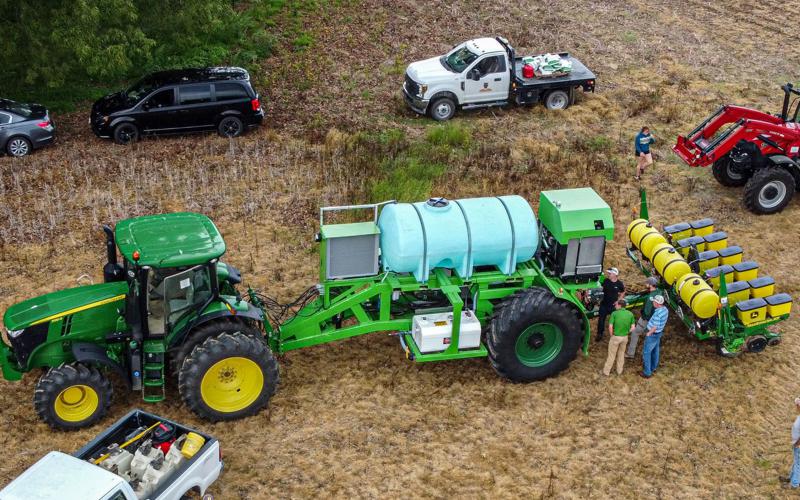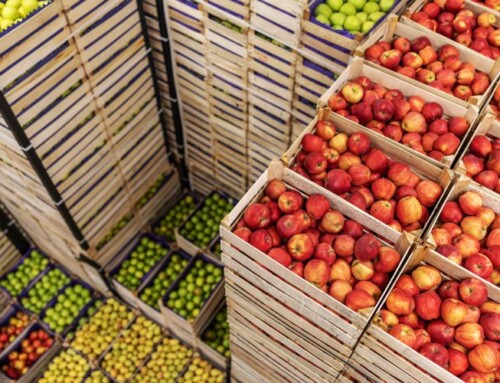BECOMING A CARROT COMPANY
The Susterre Technologies Story
If you’re considering the Carrot Ventures Company Formation Model, you might find it interesting to hear how Susterre Technologies got started.
We recently interviewed David Bunker, Founder and CEO of I-Cubed Industry Innovators Inc., Jay Kobzik, Strategic Accounts and Cedar Vandergon, Engineering Manager from Hypertherm Inc., and Michael Cully, Founder and CEO of Susterre, to help tell their story.
Why Share The Susterre Story?
Susterre is the first company launched from Carrot Ventures’ venture studio. The technology behind Susterre is the brainchild of I-Cubed, which was subsequently fostered and co-developed with Hypertherm. Susterre recently completed its seed round financing, raising over $2 million to support productization and commercialization efforts.
Susterre is pioneering the use of ultra-high pressure fluid jet technology (used to cut steel in manufacturing environments) to slice through crop residue and soil in regenerative agriculture.
The applications for using industrial cutting technology in tillage are global. With such incredible potential, why did the inventors choose to commercialize their technology with Carrot Ventures?
Focus And Speed To Market
A quick summary is that, despite their size and expertise, the two intellectual property holders do not specialize in the agricultural equipment market. Their expertise is in custom equipment fabrication and industrial cutting technologies.
The inventors knew they were on to something big, timely and important. But neither knew how to bring it to market. They didn’t know how to structure and finance an AgTech start-up. They also lacked access to someone with the mindset of a founder and the business experience of a CEO, who could turn the promise into reality.
The Carrot Company Formation Model provided the focus, expertise and experience the owners lacked. They decided the fastest way to realize the potential of the technology was for Carrot to create a new company focused on commercializing the innovation.
The Carrot model provided a straight-line path for company formation, legal support, recruiting that unique individual who is both Founder and CEO, and establishing a board of directors with industry and financial contacts. All of this happened without the need for further investment from the IP owners.
Where Did The Innovation Come From?
The idea started at a custom equipment fabricator called I-Cubed Industry Innovators based in Stoney Creek, Ontario. I-Cubed specializes in designing and fabricating unique automation tools and robotic machinery. Some of their innovations use ultra-high pressure waterjet cutting systems developed by Hypertherm. Hypertherm is a global manufacturer of industrial cutting equipment headquartered in Hanover, New Hampshire.
Several people at I-Cubed come from an agricultural background. In working with waterjet cutting systems, they realized they might be able to solve a widespread problem with conservation tillage. They started building a prototype to test their idea, which they subsequently shared with Hypertherm.
“We saw the potential of using our waterjet cutting system to help solve a global problem. The innovation aligned well with our purpose and corporate values of sustainability and the environment. After careful analysis, we decided to step up and support the initiative with equipment, engineering support, software, and IP protection,” said Kobzik.
What Problem Does The Technology Solve?
With conservation tillage, crop residue remains on the field after harvest. Over time, the crop residue accumulates, and the soil gets compacted. More pressure is needed to cut through the residue, further increasing soil compaction.
Unfortunately, the process breaks down when conventional blade-based planters can no longer slice through the residue and soil to plant. When this breakdown occurs, farmers reluctantly revert to conventional tilling. Giving up and going back to conventional tilling reduces the benefits of previous conservation efforts and discourages other farmers from adopting no-till practices in the first place.
The Novel Innovation
Michael Cully introduces the Susterre waterjet solution for conservation tillage. Source DTNPF.com
“We thought if ultra-high pressure waterjet technology can slice hardened steel, it can cut through thick crop residue for planting,” said Bunker.
“When we saw an early prototype plant corn seeds in a gravel parking lot, it inspired us. It helped us appreciate the potential, and we became champions of the technology,” said Kobzik and Vandergon.
The primary goals of conservation tillage are to stop the loss of topsoil, reduce the need for fertilizer, minimize chemical runoff, and rebuild soil structure. In addition, it is estimated that no-till methods can sequester an average of 0.3 metric tons of carbon per acre, helping reduce the carbon footprint of crop production. These benefits combine to improve soil health, which increases the farmer’s yield and profitability.
With this technology, farmers can apply the soil-building practice of conservation tillage as long as they like.
“The faster we can get this technology into the hands of farmers, the more good it can do. The idea is to retrofit existing planters, making it easy and cost-effective for traditional and no-till farmers to adopt,” says Bunker.
Exploring Commercialization Options
I-Cubed and Hypertherm decided to collaborate. They spent the next few years developing and refining their prototype.
Once field trials and IP protection effort were completed, they spent the better part of a year evaluating different commercialization options.
They considered partnering with equipment manufacturers. They approached venture capitalists, incubators, and accelerators. Nothing seemed to address the core constraints.
The same set of challenges remained. Neither company focused on agricultural equipment. They lacked experience and relevant contacts in the industry. They did not have a tested Founder-CEO to lead the venture, and were unsure how to find one. They had n experience raising capital from angels or institutional investors.
“We realized the opportunity was bigger than both companies could handle on our own,” said Kobzik. “We did not want our lack of experience and resources to stall a promising innovation.
There was also a concern that if we sold the IP to an equipment manufacturer, the idea might get shelved and never developed.“
A Chance Introduction To Carrot Ventures
A chance introduction brought the I-Cubed and Carrot Ventures teams together at an AgTech venture financing conference.
“Carrot followed up. They gave us a presentation and explained how their company formation model worked to our advantage. It was very appealing, and we thought their approach would address many of the obstacles we faced.
Carrot’s founder, Verdex Capital, has a positive reputation within the agricultural and finance sectors, and Carrot Ventures is backed by another industry leader, Farm Credit Canada (FCC). It just seemed like a really good fit. We decided to proceed and work through
Did You Face Any Internal Resistance?
According to Kobzik, there wasn’t any resistance to working with Carrot. The idea made good sense to everyone. It all came down to timing and how long it would take to commercialize the technology on their own.
“Neither I-Cubed nor Hypertherm had people working on the initiative full-time. Carrot’s background in AgTech enabled them to recruit an experienced professional to be CEO, someone who strongly identified with being the Founder and creating value for all shareholders. Having a ready-made board of directors, industry and investor contacts, and a full-time CEO focused on developing the business accelerated the process dramatically,” said Kobzik.
What Attracted The CEO?
We asked Michael Cully, the Founder and CEO of Susterre, what attracted him to Carrot Ventures and the technology. He shared the following:
“There were a few core things that got my attention. First was the technology. Of course, I did my own due diligence, but Carrot had already completed an extremely thorough assessment of the technology. They did a great job of helping me see that the opportunity was real.
Second, still related to the technology, was its purpose. If you care about farming and the environment, conservation tillage is important. The opportunity just fits for me and what I care about personally and professionally. I realized as the Founder and CEO, I could bring all my skills and experience from the ag equipment industry to the table and make a difference while growing a great company. It was very appealing.
The third thing was the Carrot process. They showed up with the intent to accelerate the company’s development from zero to worthy of institutional investment quickly.
Carrot jump started us into a much more mature business model than most start-ups would have at this stage.
They provided financial and legal support, industry experience, board-level governance, and critical insight into the institutional financing decision process right out of the gate.
Carrot likely saved us 18 months or more in setup time. They provided a straight-line path to follow, loads of support, and access to their network. With Carrot and Verdex Capital behind us, we got meetings we would have struggled to get on our own.
We’re still a start-up, but we already have mature business structures and processes, enabling us to move quickly and scale rapidly.
Because Carrot and Verdex Capital are institutional investors, they’re highly valuable in explaining what their peers expect to see. They helped shape the company structure and narrative to fit investability standards.”
Why Consider The Carrot Model?
Cully shared his thoughts on why other executives should consider the Carrot model.
“Beyond what I’ve shared already, you know that you’re not alone. You have a team of invested professionals available and a board of directors right from the outset. The team works with you to push, align and de-risk the process all at the same time.
It would take a lot of time and effort to assemble the high caliber of people and recreate the same support structures in an early-stage start-up.
I know I said this before, but Carrot’s role is to accelerate the setup, legal, financing and commercialization process in a very cost-effective and time-efficient manner. You have to look very closely at the time and risk-mitigation advantages they represent when making your decision.”
IP Holder Considerations
We asked the same question to I-Cubed and Hypertherm about what they would share with other IP holders considering the Carrot Model:
“I’m very entrepreneurial,” says Vandergon. “The biggest thing you need to recognize is where your strengths are and where they are lacking. If you look at the statistics, the failure rate of start-up ventures is high. I think they fail primarily due to a lack of expertise, which results in errors and costly delays.
If you don’t have experience in commercialization, which typically inventors don’t, it’s going to be a long road. I think you’ll have a higher potential for success and a shorter path if you partner with someone who has the experience you lack.
We’ve found that to be successful in these ventures, you need the right combination of people, the technical and business acumen, and the money. Carrot provided a means to pull all the elements together quickly.”
Kobzik added, “One of the things we appreciate about Carrot is how inclusive they are. They involved us in the whole process as they moved through the recruiting, company formation, and financing steps. We really appreciated Carrot keeping us abreast of the decision-making process. There have been no surprises and no regrets. Everything has unfolded as anticipated, and we’re excitedly watching for the next phases to unfold.”
Summary
We want to thank the contributors for sharing their insights and experience. We hope this article will help others appreciate the Carrot Ventures Company Formation Model from the perspective of the inventor, IP holders and the recruited Founder and CEO.
Learn more about the contributors at the links below.
Michael Cully is the Founder and CEO of Susterre Technologies Inc.
Michael’s Bio
David Bunker is the Founder and CEO of I-Cubed Industry Innovators Inc.
David’s Bio
Jay Kobzik is responsible for Strategic Accounts at Hypertherm Inc.
Jay’s Bio
Cedar Vandergon is the Waterjet Engineering Manager at Hypertherm Inc.
Cedar’s Bio
About The Contributors
Susterre Technologies Inc.
Susterre is pioneering ultra-high pressure fluid jet technology in row crop applications to reduce the costs and technical barriers that limit the adoption and practice of conservation tillage. Learn More.
Hypertherm
Hypertherm is a global manufacturer of industrial cutting equipment headquartered in Hanover, New Hampshire. Learn More.
I-Cubed Industry Innovators
I-Cubed is a high-tech machinery manufacturer providing automation solutions. They are a Canadian corporation with more than 60 employees operating in Stoney Creek, Ontario. Learn More.
About Carrot Ventures Fund I, LP
Carrot Ventures is a venture capital fund focused on early-stage agricultural technologies. Their novel approach to AgTech commercialization offers intellectual property holders “The Third Option” to commercialize promising innovations. The fund is a venture capital partnership between Verdex Capital and Farm Credit Canada. Carrot is not a funding source for existing companies. Learn More.




